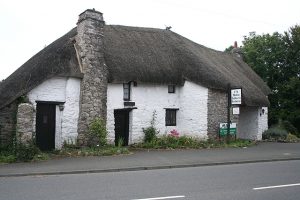An ultra-low embodied carbon building from locally-grown hemp.
.
A piece in yesterday’s Telegraph by Simon Heffer laments “the failure to build with local materials, whether stone or red brick” (paywall):
The era of ‘cheap and nasty’ housing has to end – Britain doesn’t need more ugly estates.
.
 An important point is that ‘cheap and nasty’ is actually rather expensive – and that making housing with local materials is cheaper, with a piece from the Independent some five years ago making that point:
An important point is that ‘cheap and nasty’ is actually rather expensive – and that making housing with local materials is cheaper, with a piece from the Independent some five years ago making that point:
Housebuilders go back to basics by using traditional methods and materials | The Independent
.
Devon, of course, is famed for its cob – although much of its thatch is imported:
.
Whilst other naturally-occurring materials are just right for many reasons:
Ideas for energy-efficient building – Vision Group for Sidmouth
The New Stone Age: ancient material: tiny carbon footprint – Vision Group for Sidmouth
.
Then there is hemp, as highlighted in the latest Architects’ Journal:
.
From farm to form: Flat house by Practice Architecture
Film director-turned-hemp farmer Steve Barron commissioned Practice Architecture to help him ‘grow’ a prototype house using his own crop. The result is Flat House, an ultra-low embodied carbon building the team is now looking to reproduce at scale. Rob Wilson interviewed Paloma Gormley, partner at Practice Architecture, to find out more.
…
Plants sequester carbon as they grow, so if large transport distances aren’t involved, plant-based materials store more carbon than they produce. Hemp is fast-growing and better than commercial forestry at sequestering carbon – and its long tap roots help to regenerate the soil. Beyond the relatively light processing and transportation emissions, the materials can be understood to be carbon-neutral (or carbon-negative if you count the sequestration), which is a vast improvement on steel, concrete, or petrol-based insulations.
Compared with conventional construction, the building is radically low in embodied carbon. It’s important to remember that carbon calculating is a fairly blunt tool when it comes to designing for ecology and we really need to be going much deeper in understanding the impact of the things we make. Crucially, bio-materials can be non-toxic, they don’t give off gas and can be returned to the ground in the form of mulch at the end of their life cycle. I’ve begun tentatively using the phrase ‘circular ecology’, an attempt to describe a construction logic in which buildings emerge from, and then reintegrate into, the landscape.
From farm to form: Flat house by Practice Architecture | Building | Architects Journal
.
See also:
Hemp is used on the inside and out of Cambridgeshire’s Flat House
Flat House review – a home made from hemp that will blow your mind | Art and design | The Guardian
.
photo: File:Yealmpton, Old Mother Hubbards Cottage – geograph.org.uk – 1490387.jpg – Wikimedia Commons